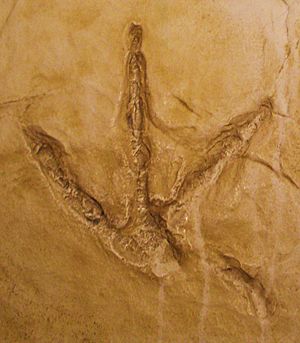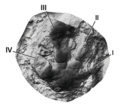Saurexallopus facts for kids
Quick facts for kids Saurexallopus |
|
|---|---|
 |
|
| Trace fossil classification |
|
| Ichnoclass: | Reptilipedia |
| Ichnocohort: | Theropodipedia |
| Ichnogenus: | †Saurexallopus Harris, 1997 |
Saurexallopus (Pronunciation: Saw-ex-allo-pu) is the name given to a special kind of trace fossil. A trace fossil is not a bone or a tooth, but rather a sign of an animal's activity, like a footprint. In this case, Saurexallopus is the scientific name for a fossil footprint. Scientists are not completely sure which animal made these specific footprints, but they think it might have been a bird or a bird-like dinosaur.
Contents
What is a Trace Fossil?
A trace fossil is different from a body fossil, which is the actual remains of an ancient animal or plant, like a bone or a leaf. Trace fossils show us what ancient creatures did. They are like clues left behind.
Types of Trace Fossils
- Footprints: Like Saurexallopus, these show how an animal walked.
- Burrows: Tunnels dug by animals in the ground or under water.
- Nests: Places where animals laid eggs or raised their young.
- Coprolites: Fossilized animal droppings, which can tell us what they ate!
Trace fossils are very important because they help scientists understand how ancient animals lived, moved, and behaved, even if we don't find their actual bodies.
Who Made the Saurexallopus Footprints?
The animal that made the Saurexallopus footprints is still a bit of a mystery! Scientists call these types of fossils an ichnogenus, which means it's a genus (a group of related species) based only on trace evidence, not on the animal's body itself.
Clues from the Footprints
The shape and size of the Saurexallopus footprints give us clues. They look like they were made by a two-legged animal with three toes pointing forward. This kind of foot is often seen in birds and some types of dinosaurs.
Birds or Dinosaurs?
Because the footprints are from the Upper Cretaceous period, which was the very end of the age of dinosaurs, it's possible they were made by an early bird. Many small, bird-like dinosaurs also lived during this time. These dinosaurs were closely related to birds and had similar feet. So, while we can't say for sure, the footprints likely belong to either a bird or a small, bird-like dinosaur.
When Did Saurexallopus Live?
The Saurexallopus footprints were found in rocks from the Upper Cretaceous period. This time was about 100 to 66 million years ago. It was the last part of the Mesozoic Era, often called the "Age of Dinosaurs."
The World in the Upper Cretaceous
During the Upper Cretaceous, the Earth looked different from today. Continents were still moving apart, and the climate was generally warm. Many different kinds of dinosaurs roamed the land, including giant plant-eaters and fierce predators. This was also a time when flowering plants became more common, and early birds were evolving. Finding Saurexallopus footprints helps us imagine what life was like in this ancient world.
Images for kids


